20 Types Of Holly Plants-what’s best for your landscape?
Are you looking for a low maintenance evergreen shrub or tree? You may want to consider a holly plant variety. There are twenty holly varieties listed in our holly landscape guide below.
Holly bushes have the remarkable ability to enhance the timeless elegance of any garden. The bonus is that these shrubs and trees are low-maintenance and evergreen that provide enduring aesthetic appeal. Which holly species is best for your landscape?
So, how do you choose the best holly variety for your landscape?
There is twenty holly plant types. The world of holly is incredibly diverse, ranging from dwarf varieties to large trees. Who knew?
From their vibrant green leaves to their festive red berries, holly adds a touch of charm to any garden. When you think of ‘holly,’ do you envision vibrant red berries on Christmas decorations? I don’t blame you, I do too.
But what if I told you that holly shrubs and trees are much more than that? Their beauty and versatility extend far beyond festive adornments, making them a splendid addition to your landscaping.
In this comprehensive guide, we’ll delve into the diverse world of holly, encompassing deciduous holly, evergreen hollies, and everything in between, to assist you in making an informed choice regarding the ideal holly species for your garden.
Holly Shrubs and Plant Species-Landscape Guide
Are you ready to embark on a shrub-tastic journey through the world of holly? No matter if you’re a seasoned gardener or just someone with a penchant for all things green and gorgeous, you’ve come to the right place!
Are you looking for a low maintenance evergreen shrub? Or, perhaps you are looking to add texture and color to your garden? Whatever the reason, holly may be an ideal plant to consider. Which type? I hope our guide will help you determine that.
Grab your gardening gloves and prepare to explore the fantastic realm of holly shrubs, where vibrant foliage meets festive charm.
Choosing the Perfect Holly Bushes for Sale
In this blog post, we’ll unravel the mysteries of holly shrub selection. I was surprised to discover how many varieties of shrubs exist. Many holly shrubs don’t even look like the jagged edge holly we are accustomed to seeing.
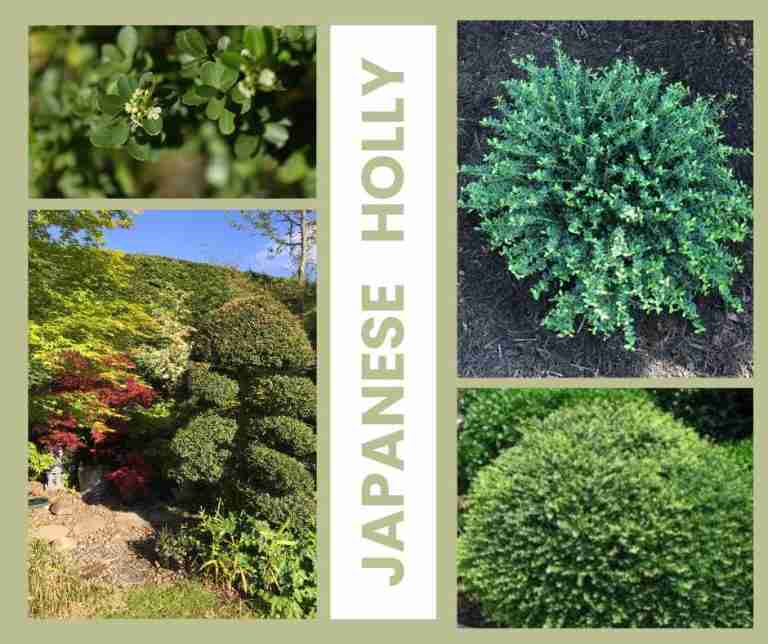
1
Japanese Holly (Ilex crenata):
This type of holly is known for its small, dark green leaves, Japanese holly is a compact and versatile evergreen shrub. Its tidy appearance makes it an excellent choice for hedges and borders.
Th leaves that resemble boxwood leaves. Which is why pruning can help maintain its desired shape and size and works well as topiary. This evergreen shrub is native to Japan, Korea, and parts of eastern China.
Female Japanese Holly plants produce small, inconspicuous black or dark purple berries, which are not typically as showy as those of other holly species. It performs best in partial to full sun. This holly is drought-tolerant.
This shrub is well-suited to regions with temperate climates.
- Native Area: China, Korea, and Japan
- USDA Growing Zones: 5 to 8
- Height: 3 to 6 feet
- Sun Exposure: Full sun to part shade
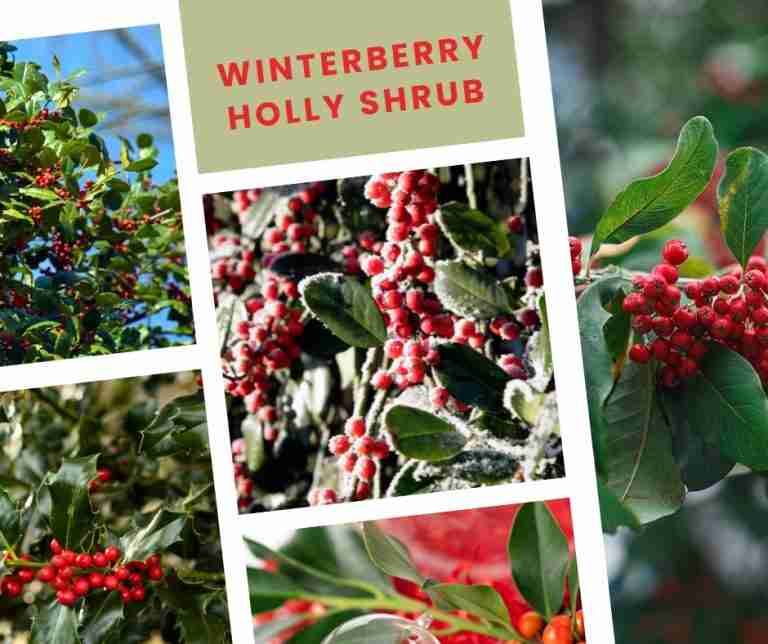
2
Winterberry Holly (Ilex verticillata):
This deciduous holly dazzles with its red berries, making it a showstopper in winter gardens. The berries add a pop of color against the backdrop of its bare branches.
The most striking feature of Winterberry Holly is its clusters of red berries, which are typically spherical and about a quarter-inch in diameter. These berries persist on the plant throughout the winter, providing a valuable food source for birds, including cedar waxwings and robins.
Growing Winterberry Holly (Ilex verticillata) is a rewarding endeavor to plant. It adds vibrant red berries to your garden during the winter months and provides a burst of color when many other plants are dormant.
- Native Area: Eastern North America
- USDA Zones: 3 to 9
- Height: 6 feet to 12 feet
- Sun Exposure: Full sun to part shade
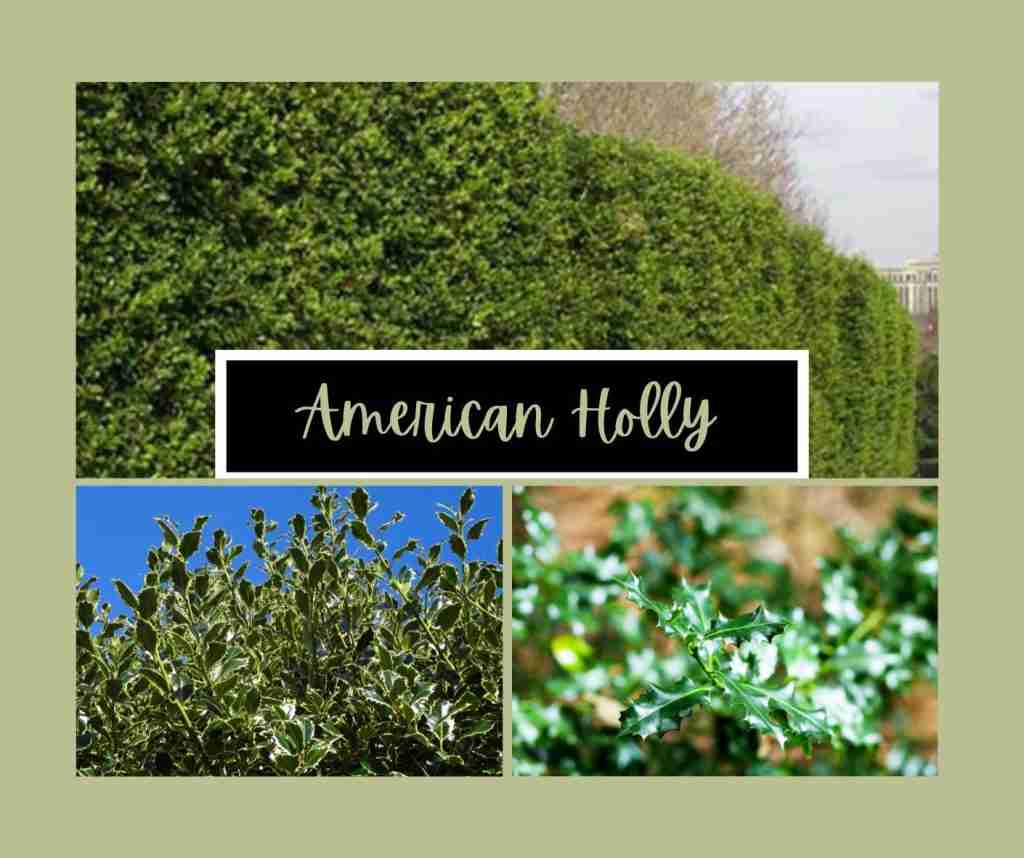
3
American Holly (Ilex opaca):
A quintessential holly species, the American holly boasts glossy dark green leaves and red berries. It’s a true symbol of traditional holiday cheer.
American holly, is also known as “hummock holly”. It is often used as a replacement for English holly in Christmas decorations, especially in areas where this type of holly doesn’t grow.
They share a similar appearance with spiky-toothed leaves and an abundance of vibrant red berries. This holly variety goes by several common names, including dune holly and scrub holly.
- Native Area: Southern and eastern United States
- USDA Zones: 5 to 9
- Height: 15 feet to 60 feet
- Sun Exposure: Full sun to part shade
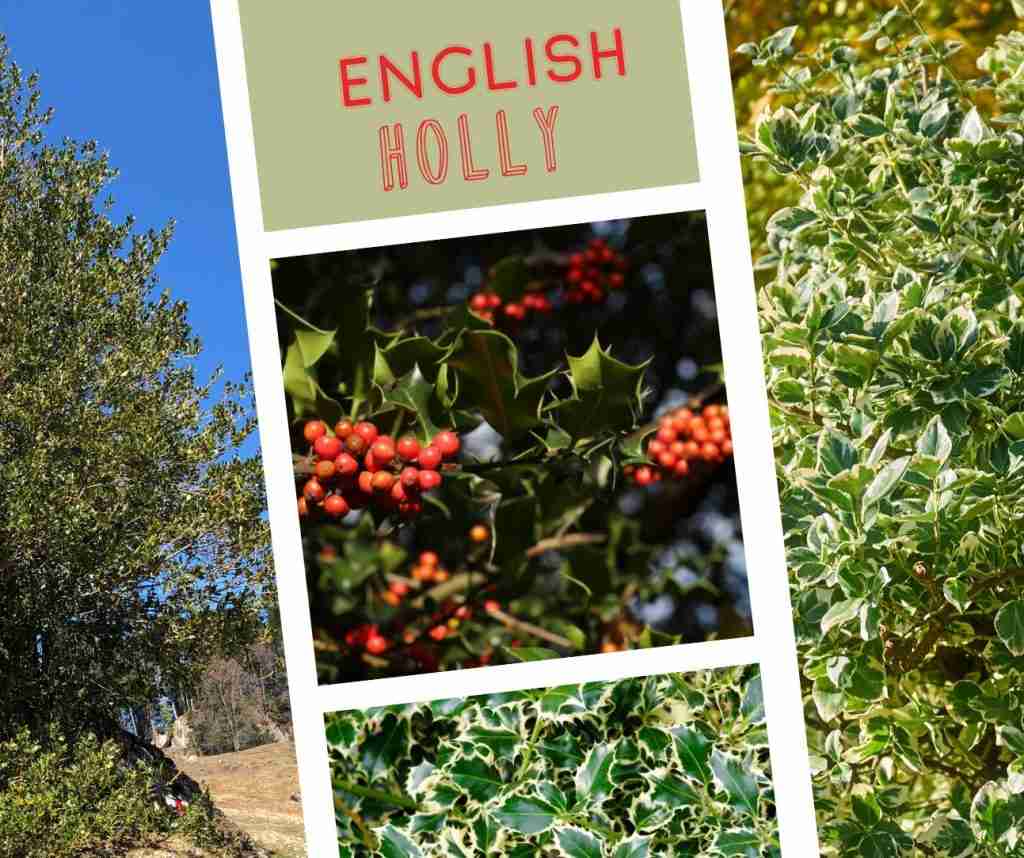
4
English Holly (Ilex aquifolium):
English Holly, is also known also as “Ilex aquifolium”. This evergreen shrub and small tree is native to Western and Southern Europe, as well as North Africa. It is characterized by its distinctive glossy, dark green leaves with sharp spiky leaves.
The leaf edges have clusters of red berries which is why English holly is a popular ornamental plant and is often associated with Christmas. It has a festive appearance. This holly is often used in holiday decorations.
Please note that English holly can be very invasive in some regions, particularly in parts of North America.
- Native Area: Europe, Asia, and Africa
- USDA Growing Zones: 7 to 9
- Height: 15 to 50 feet
- Sun Exposure: Full sun to part shade
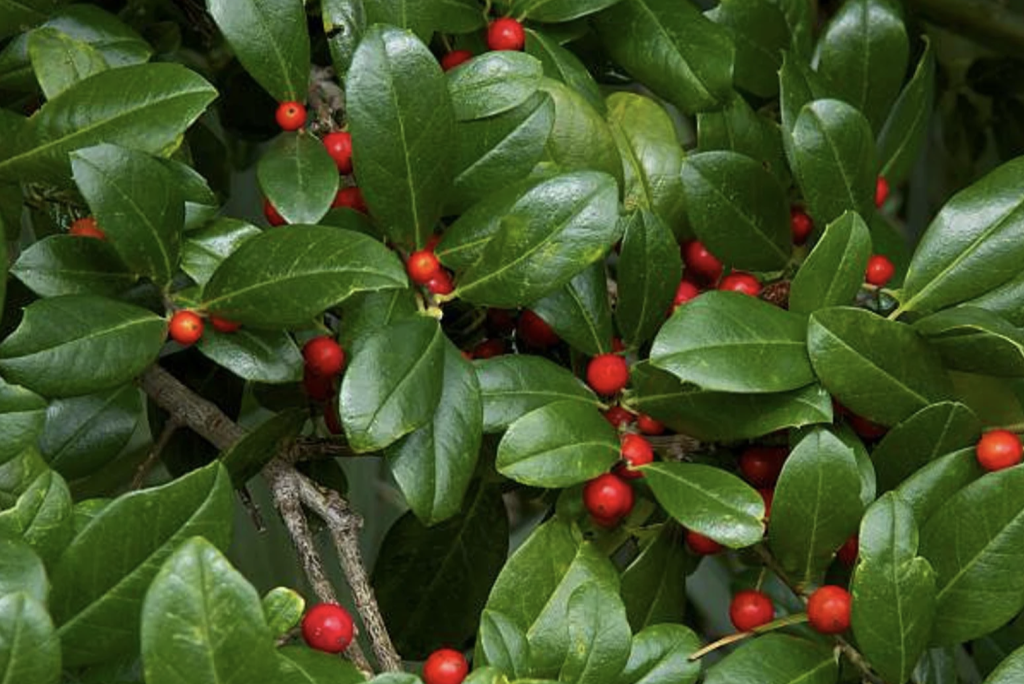
5
Yaupon Holly (Ilex vomitoria):
Native to the southeastern United States, this evergreen holly type features petite leaves and red berries. This variety of holly makes a charming addition to both formal and informal landscapes because it is a versatile evergreen shrub or small tree.
Yaupon Holly, scientifically known as Ilex vomitoria. It’s leaves are known for its small, oval to elliptical leaves that are dark green and glossy. The leaves have a leathery texture and are typically about 1 to 1.5 inches long.
It can grow as a shrub or small tree, with mature heights ranging from 6 to 20 feet, depending on the variety and growing conditions.
Female Yaupon Holly plants produce small, round, and bright red berries. These berries persist on the plant throughout the winter, providing a valuable food source for birds and wildlife. Inconspicuous white flowers bloom in the spring, typically in April or May. They are pollinated by bees and other insects.
Drought and Salt Tolerant
Yaupon Holly is known for its exceptional drought tolerance once established. It can thrive in challenging conditions including it’s salt-tolerant, making it a valuable plant for xeriscaping and water-efficient landscaping.
This holly variety can be pruned and shaped to suit various landscape designs, including hedges, screens, topiaries, and small ornamental trees.
Cultural and Historical Significance:
Historically, Yaupon Holly has cultural significance among Native American tribes. The leaves of the plant were used to prepare a caffeinated beverage known as “yaupon tea.” Contrary to its scientific name’s implication (vomitoria), the tea was not known to induce vomiting and was used for its stimulating properties.
- Native Area: Southeastern United States
- USDA Zones: 7 to 9
- Height: 4 to 30 feet
- Sun Exposure: Full sun to part shade
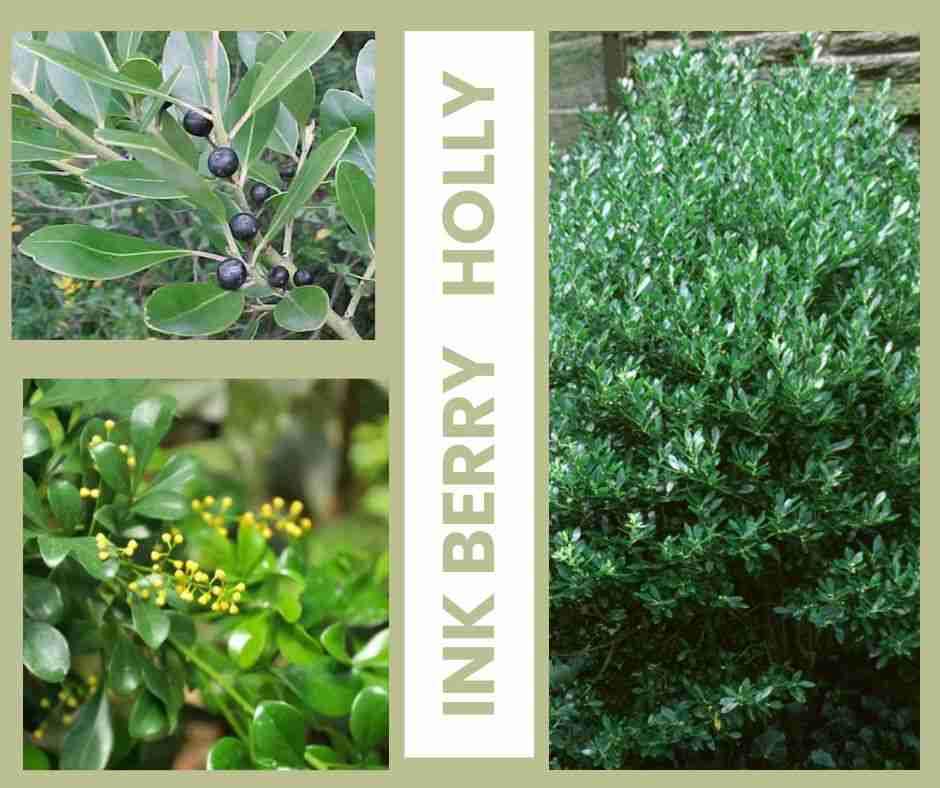
6
Inkberry Holly (Ilex glabra):
Inkberry Holly, is also known as Ilex glabra. It’s a versatile evergreen shrub native to eastern North America, including regions of the eastern United States and eastern Canada. It’s dense foliage and small black berries, is what the shrub is known for. The inkberry holly is a versatile evergreen shrub that can thrive in partial shade.
Unlike some holly species, the leaves of Inkberry Holly lack the typical sharp spines or teeth along the margins. The leaves have a relatively smooth-edged.
This holly shrub typically grows as a dense, compact shrub with a rounded or mounded form. It typically reaches a height of 3 to 8 feet, with some cultivars capable of reaching slightly taller heights.
Black Inkberries
Female Inkberry Holly plants produce small, jet-black berries that remain on the plant throughout the winter. These berries provide a valuable food source for birds and wildlife, making it a wildlife-friendly plant.
Inconspicuous greenish-white flowers bloom in the spring, attracting pollinators like bees. While the flowers are not particularly showy, they are an essential part of the plant’s reproductive cycle.
- Native Area: Eastern and south-central U.S.
- USDA Growing Zones: 5 to 9
- Height: 4 to 8 feet
- Sun Exposure: Full sun to part shade
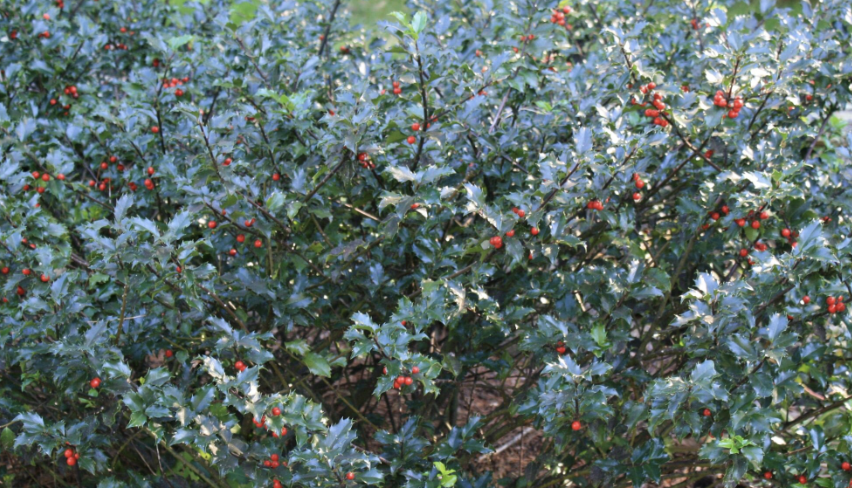
7
Blue Holly (Ilex x meserveae):
This hybrid holly type offers striking blue-green foliage and colorful berries, making it a unique and attractive choice for gardens. Blue Holly, scientifically known as Ilex × meserveae, is a hybrid holly plant resulting from a cross between two holly species: Ilex rugosa and Ilex aquifolium.
Blue Holly is known for its distinctive blue-green or bluish-gray foliage, which sets it apart from many other holly varieties. The leaves are typically glossy and have spines or serrations along the edges and product red berries.
Like other holly species, Blue Holly produces small, inconspicuous white flowers that bloom in late spring. These flowers are typically pollinated by bees and other insects.
It prefers well-drained, slightly acidic to neutral soil. Amending the soil with organic matter can enhance its growth.
Blue Holly cultivars are prized for their attractive foliage and berries, making them suitable for various garden settings, including hedges, borders, and mixed shrub plantings.
For instance, the unique blue-green color leaves adds a distinctive touch to landscapes, and the berries provide winter interest while supporting local wildlife.
- Native Area: Nursery Hybrid
- USDA Growing Zones: 5 to 7
- Height: 10 to 15 feet at mature
- Sun Exposure: Full sun to partial shade
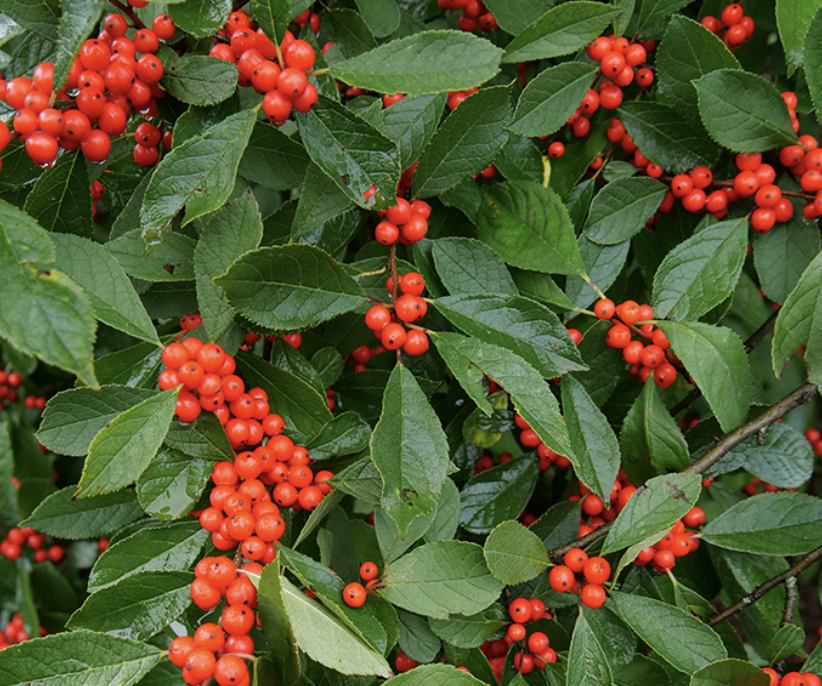
8
Common Winterberry Holly (Ilex verticillata):
The common winterberry shrub adds a vibrant burst of color to your winter landscape, courtesy of its abundant scarlet berries. The leaves have soft edges.
This hardy species thrives in damp environments, typically found in native habitats like bogs and swamps. It’s worth noting that the winterberry may produce suckers, which can lead to it spreading throughout your yard.
When searching for this plant please note, that it goes by several names. Here is a list of names to look for: Coralberry, black alder, Michigan holly, Canada holly, deciduous holly, fever bush, Virginian winterberry, brook alder, and swamp holly.
- Native Area: Eastern North American
- USDA Growing Zones: 3-9
- Height: 6 to 12 feet at mature
- Sun Exposure: Full sun to partial shade
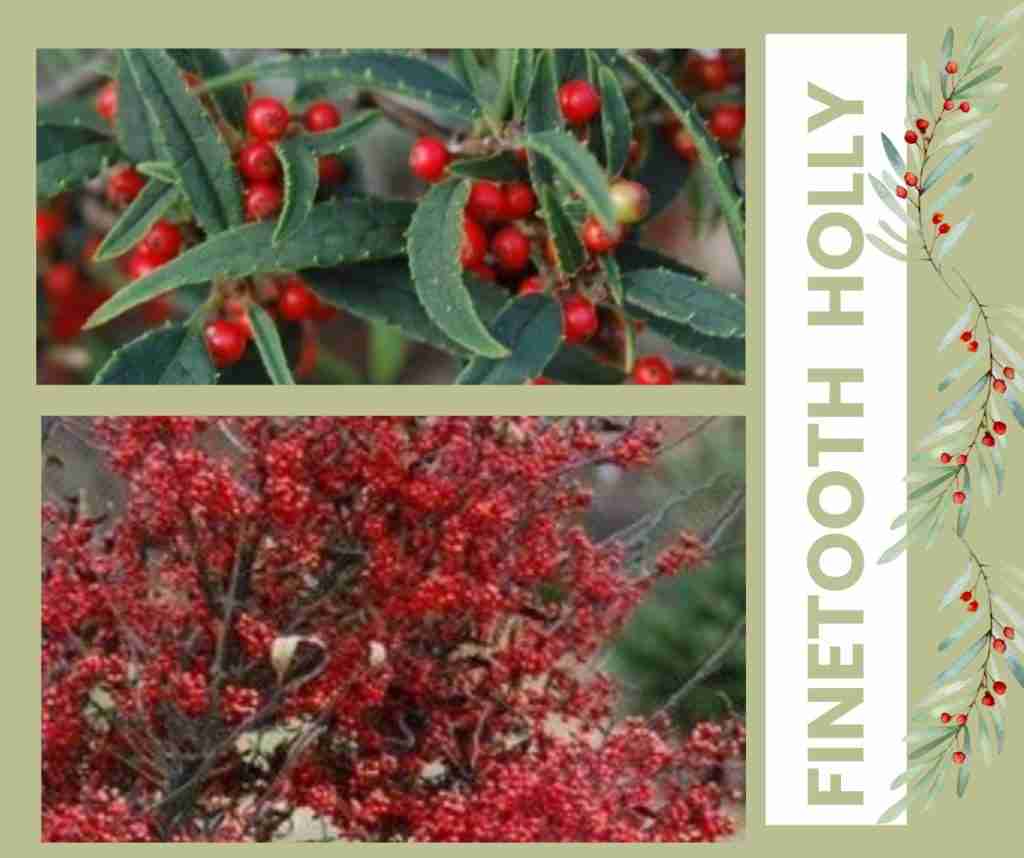
9
Finetooth Holly Bush (Ilex serrata ‘Koshobai’):
The Finetooth Holly, is also known as Ilex serrata. It’s a species of holly bush native to eastern Asia, particularly regions in Japan, Korea, and China. It is a deciduous shrub known for its ornamental qualities and is a member of the Ilex genus, which includes various holly species.
The holly leaves are typically oval to elliptical in shape and have finely serrated or toothed margins, giving it its common name, “Finetooth Holly.” The leaves are glossy green in summer and may turn various shades of red or purple in the fall, adding to its ornamental appeal.
The Female Finetooth Holly Plant
Female Finetooth Holly plants produce small, round, red berries that often persist into the winter, providing a source of food for wildlife.
This shrub typically grows as a compact, multi-stemmed shrub and can reach heights of 6 to 10 feet with a similar spread. As for where the Finetooth Holly grows well, it is well-suited to grow in temperate climates in part to full sun in well drained soil.
- Native Area: Japan, Korea and China
- USDA Growing Zone: 6
- Height: 6 to 10 feet at mature
- Sun Exposure: Full sun to partial shade
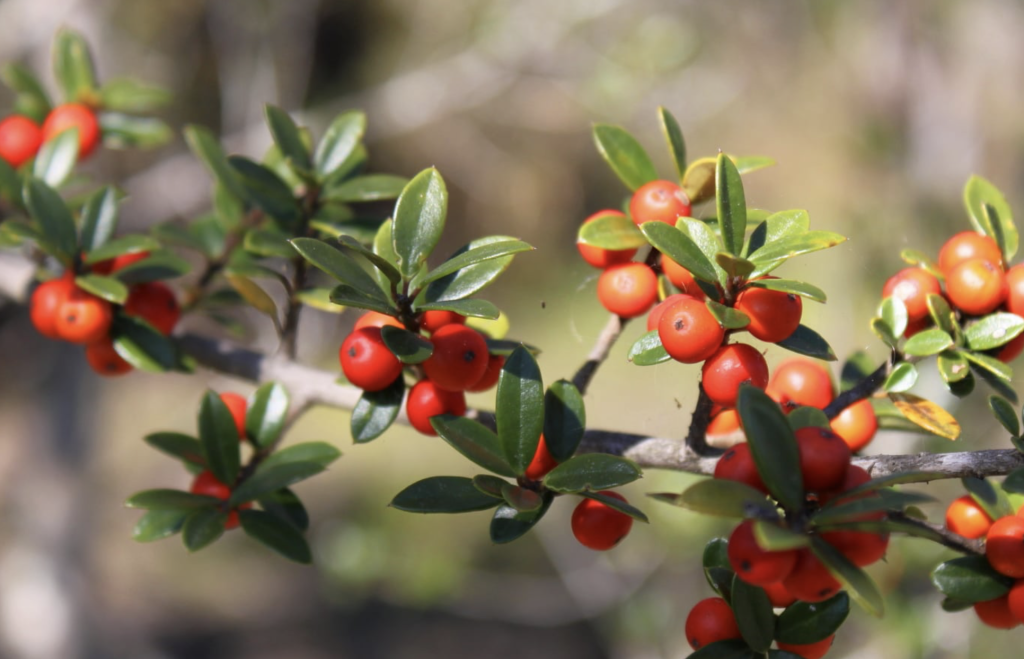
10
Myrtle Leaved Holly Bush (Ilex myrtifolia):
The Myrtle-Leaved Holly Bush, known as Ilex myrtifolia, is a distinctive evergreen shrub or small tree known for its unique leaves that resemble those of the common myrtle.
The leaves of the Myrtle-Leaved Holly are tiny, smooth and spineless. Some botanists consider this to be a variety of the dahoon holly (Ilex cassine) and the two are said to cross sometimes.
Other common names for this plant include: dahoon, myrtle dahoon, myrtle holly, and myrtleleaf holly.
- Native Area: Southeastern U.S.
- USDA Growing Zones: 7 to 10
- Height: Usually 15 to 25 feet, but can reach more than 40 feet
- Sun Exposure: Full sun to part shade

11
Small-Leaved Holly (Ilex canariensis):
The small-leaved holly comes from a couple of islands near the north African coast and grows in a type of forest called laurisilva or laurel forest.
Small-Leaved Holly is primarily grown as an ornamental plant in gardens and landscapes. It is valued for its attractive foliage and occasional berry production, which adds visual interest to outdoor spaces. In its native habitat, it can be found in forests and woodlands.
Small-Leaved Holly is prized for its elegant appearance and adaptability to subtropical landscapes, making it a charming addition to gardens in the Canary Islands, Madeira, and other regions with similar climate conditions.
- Native Area: South- African Coast
- USDA Growing Zones: 11-12
- Height: Up to 35 ft
- Sun Exposure: Full sun to part shade
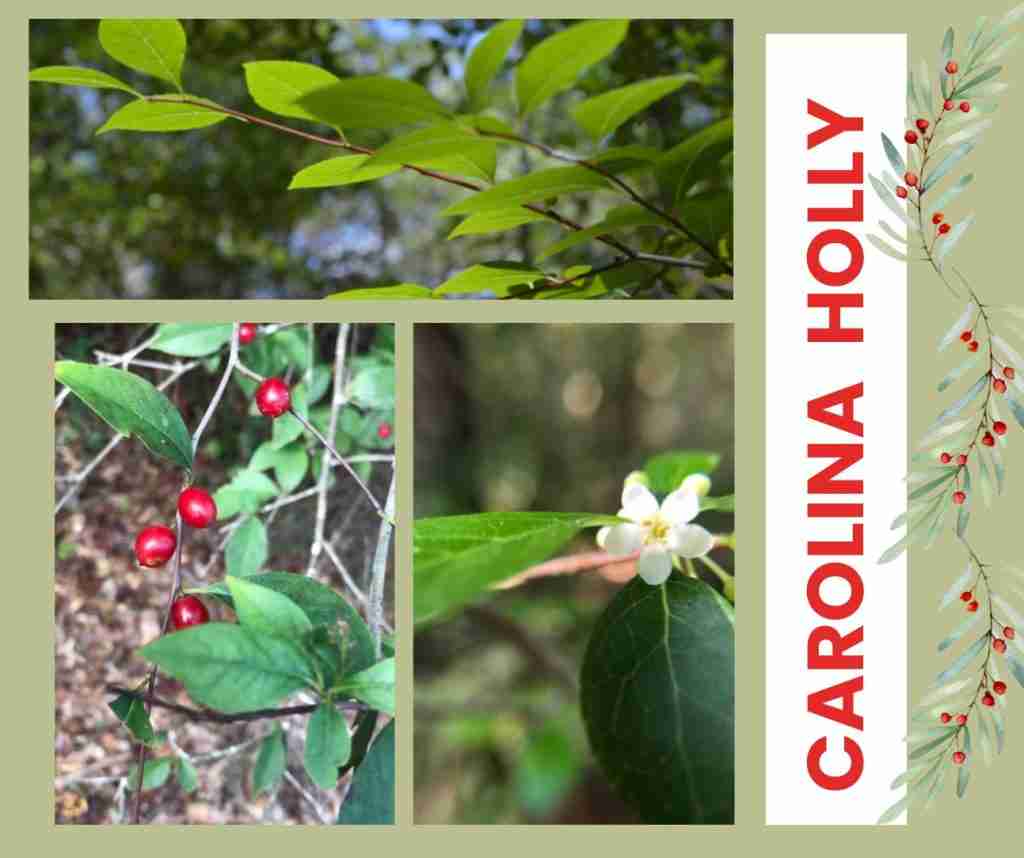
12
Carolina Holly (Ilex ambigua):
Carolina Holly (Ilex ambigua) originates from the southeastern and south-central regions of the United States. It thrives in a range of sun conditions, from full sun to partial shade.
This holly variety is popularly known as sand holly–because it grows well in sandy soils. This is a deciduous species that grows mainly in the south-central and the southeastern United States. The plant produces bright red berries in the fall.
Its leaves are typically green with distinctive toothed or wavy margins. An interesting feature of Carolina Holly is its fruit, which tends to be more elongated or elliptical, setting it apart from the rounder fruit of the American holly.
- Native Area: South- Central Regions
- USDA Growing Zones: 1
- Height:
- Sun Exposure: Full sun to part shade
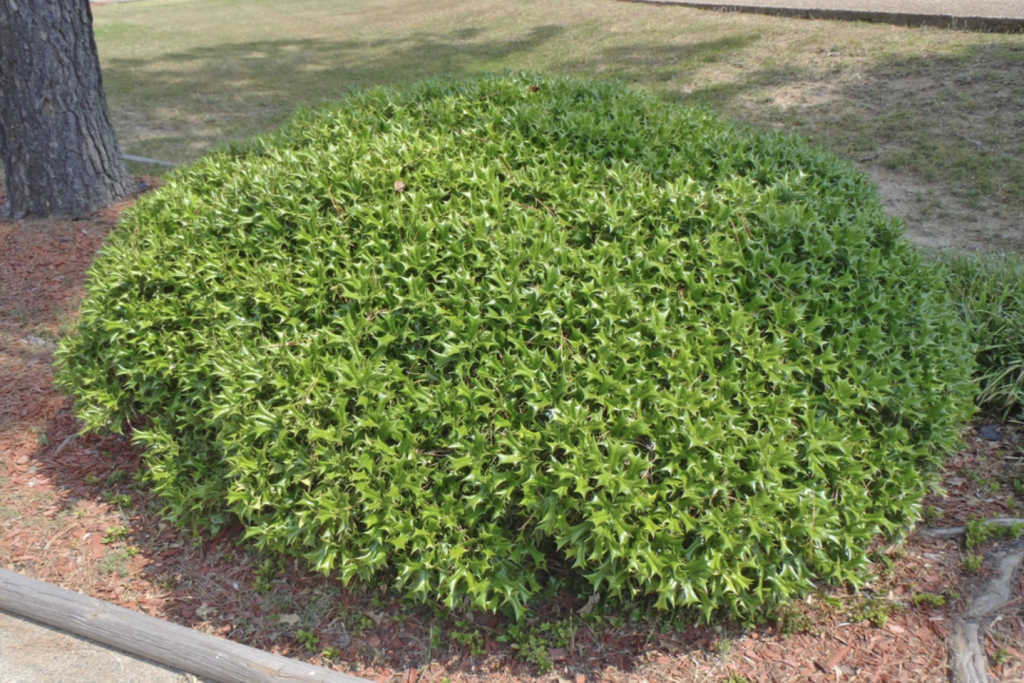
13
Chinese Holly (Ilex cornuta):
Chinese Holly (Ilex cornuta) is a popular choice for planting in gardens and landscapes for several reasons.
The unique leaf shape adds visual interest to the landscape and sets it apart from other holly species.
It typically has a compact, dense growth habit, making it suitable for various garden settings. It can be used as a hedge, border plant, or ornamental specimen.
Chinese Evergreen Shrub
This evergreen shrub,looks great all year around. Female plants produce small, colorful berries, usually red. These berries are visually appealing and attract birds, adding a dynamic element to the garden. Bird enthusiasts often appreciate the plant for the wildlife it attracts.
Its unique foliage, year-round attractiveness, and adaptability make it a favored choice among gardeners and landscapers for various landscaping needs.
- Native Area: China and Korea
- USDA Zones: 7 to 9
- Height: 6 feet to 25 feet, depending on the variety
- Sun Exposure: Full sun to part shade
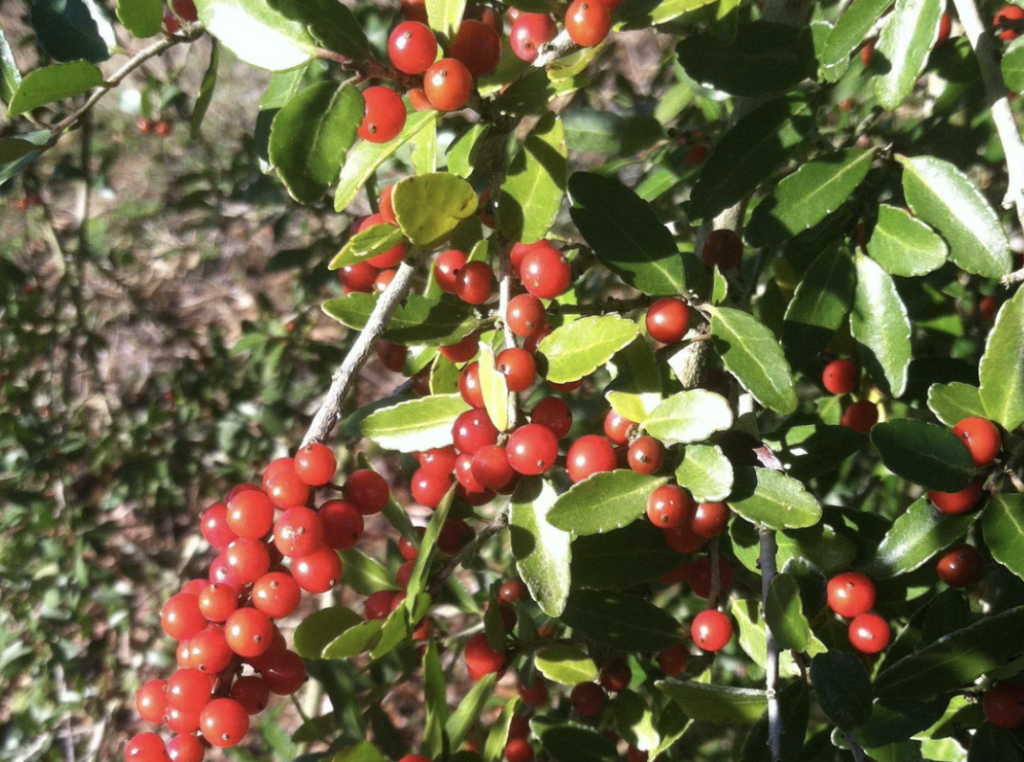
14
Round Leaf Japanese Holly (Ilex cornuta):
Japanese Round leaf holly, known as Ilex rotunda, is characterized by its distinctive round-shaped leaves. Surprised?
As the name suggests, the most distinguishing feature of this plant is its round leaves. The leaves are typically glossy and dark green, with a smooth, rounded shape, and they have a leathery texture.
It’s a slow-growing evergreen that can reach heights of up to 20 feet (6 meters) in the right conditions. It often forms a dense, rounded or oval shape.
In the spring, it produces small, inconspicuous white flowers. Red berries are produce in the fall and winter. This holly shrub makes for an ideal ornamental tree in gardens, parks and landscapes.
- Native Area: Japan and Asia
- USDA Zones: 8-9
- Height: 20+ feet,
- Sun Exposure: Full sun to part shade
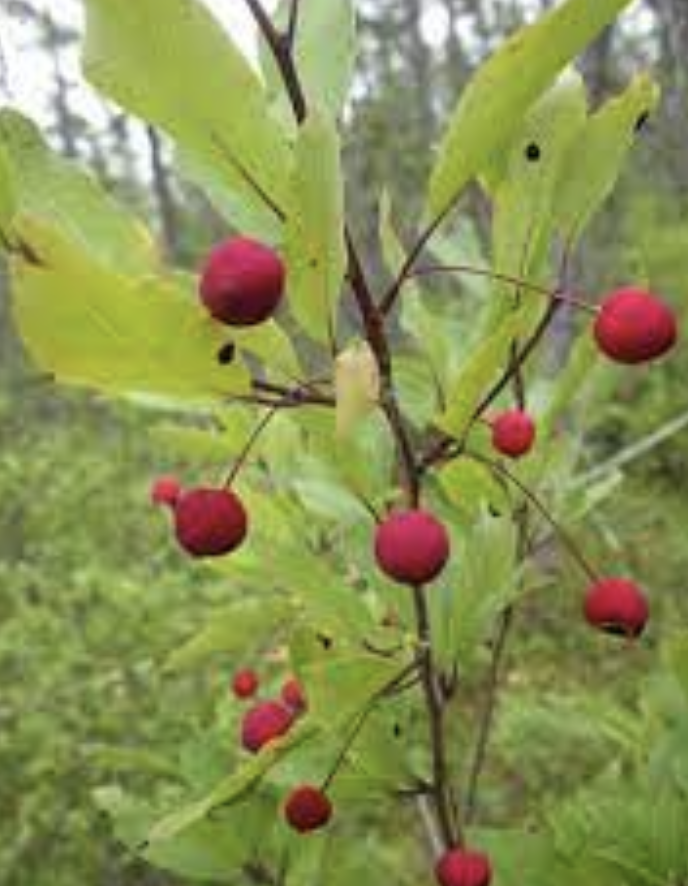
15
Mountain Holly (Ilex Opaca):
Mountain holly, is also known as American holly (Ilex opaca). It’s native to the southeastern United States. It is commonly referred to as the Catberry. is the only native holly within Eastern North America. TIt is a popular evergreen shrub or small tree known for its spiky, glossy, dark green leaves and bright red berries.
Mountain holly prefers well-draining, slightly acidic to neutral soil. If your soil is too alkaline, you can amend it with organic matter like peat moss or compost to lower the pH.
- Native Area: Southeastern United States
- USDA Zones: 3-6
- Height: 10 ft tall
- Sun Exposure: Full sun to part shade
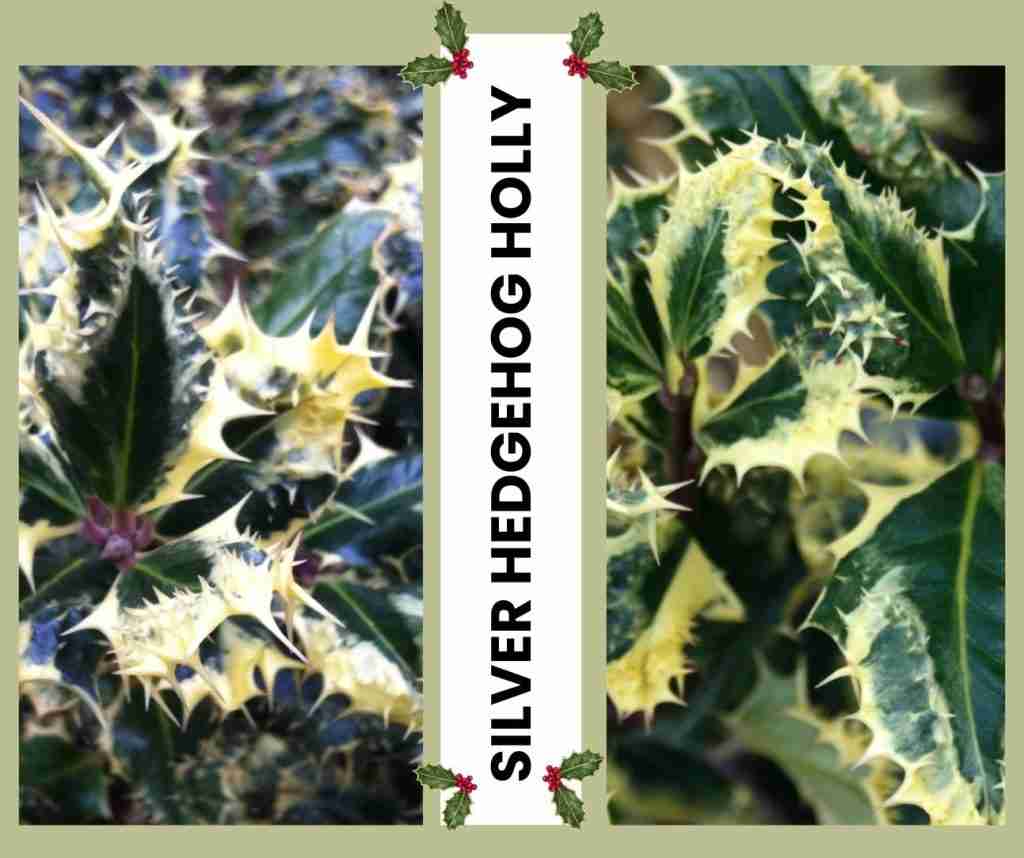
16
Silver Hedgehog (Ilex Aquifoliumferox Argentea)
Hedgehog holly is unique and visually striking evergreen shrub or small tree known for its distinctive foliage. Here are some key characteristics and information about the silver hedgehog holly (likely a variety or cultivar of Ilex):
The most notable feature of the silver hedgehog holly is its spiny leaves that are described as extra prickly. The leaves have a silver or cream-colored margin around their edges, creating a striking contrast with the wine-colored stems. This textural appearance makes it a visually interesting plant.
In spring, silver hedgehog hollies produce small, insignificant white flowers. These flowers are a source of pollen for female holly plants, which produce the berries.
- Native Area: Native to the UK
- USDA Zones: 3-6
- Height: 5 ft tall
- Sun Exposure: Full sun to part shade
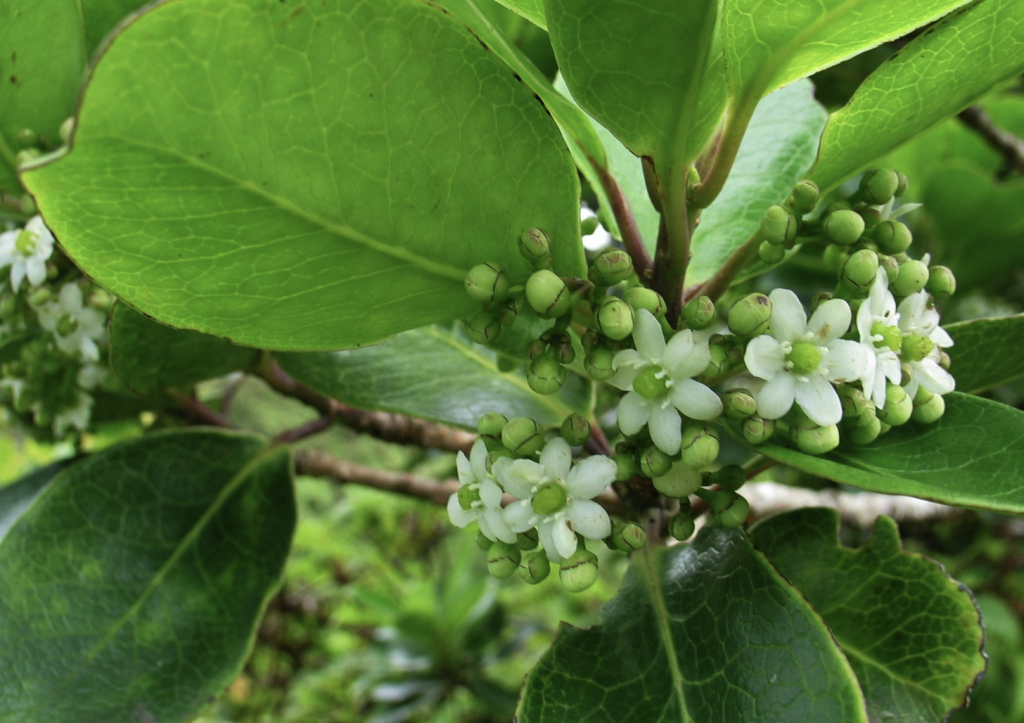
17
Hawaiian Holly (Llex Anomala);
Hawaiian Holly is also known as Ilex anomala. This holly variety is native to the Hawaiian Islands, particularly Maui and Hawai’i (the Big Island).
Hawaiian Holly is recognized for its elliptical to oblong leaves with a glossy, dark green color. The leaves have smooth margins (without spines or serrations), which distinguishes it from many other holly species.
This holly species typically grows as a small to medium-sized tree or large shrub, reaching heights of up to 20 feet. It has a bushy and dense growth habit.
This holly species produces small, inconspicuous, and typically greenish-yellow flowers. The female plants produce tiny red or orange-red berries.
- Native Area: Hawaii
- USDA Zones: 11-12
- Height: 20+ feet
- Sun Exposure: Full sun to part shade

18
Lusterleaf Holly (Ilex Latifolia):
Lusterleaf Holly, scientifically known as Ilex latifolia, is a holly species known for its glossy, lustrous green leaves. Here are some key characteristics and information about Lusterleaf Holly:
Lusterleaf Holly is recognized for its large, glossy, and broad green leaves. The foliage of the shrub is rich and shiny, hence the name “lusterleaf.”
In China, the leaves of Lusterleaf Holly are used to brew tea. This traditional use adds cultural significance to the plant.
- Native Area: China and Japan
- USDA Growing Zones: 7 to 9
- Height: 15 to 25 feet tall, sometimes up to 60 feet in native locations
- Sun Exposure: Full sun to part shade
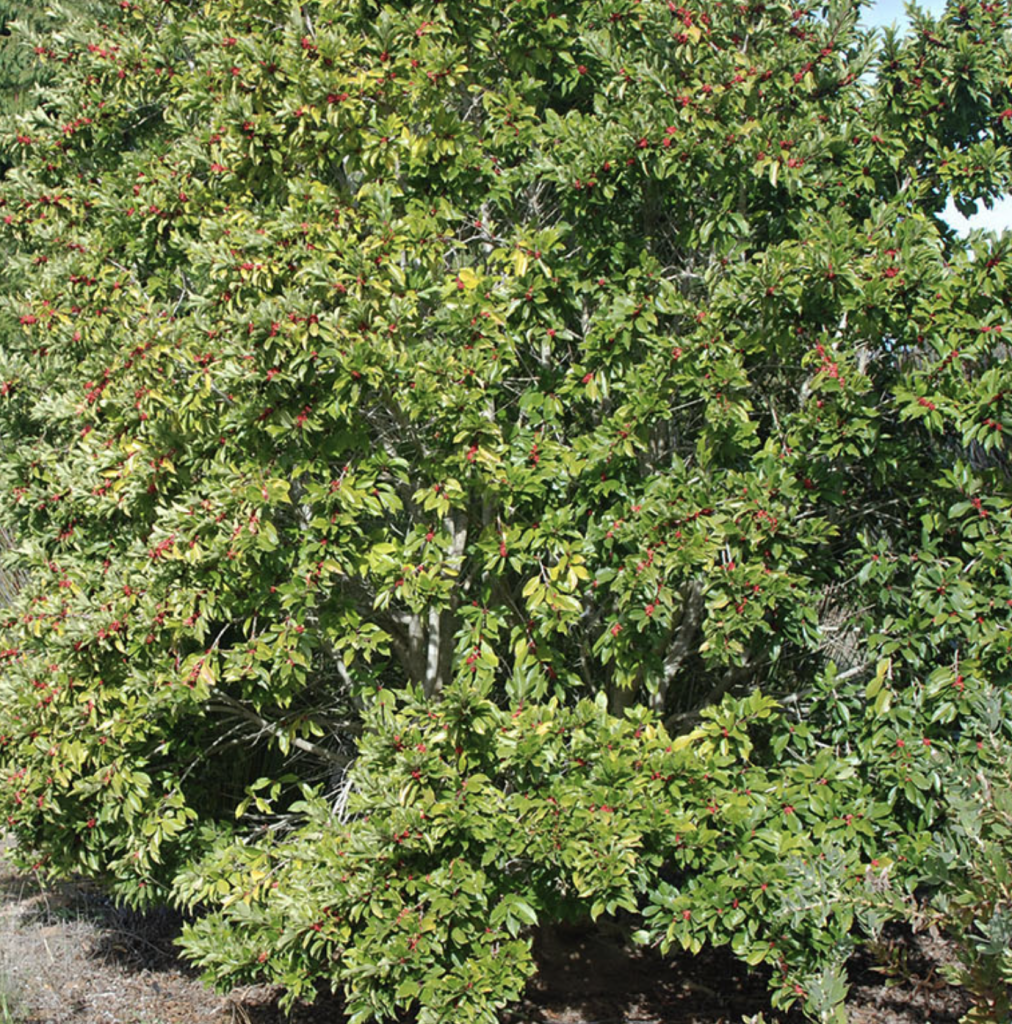
19
Yerba Mate Holly (Ilex paraguariensis):
Yerba Mate (Ilex paraguariensis) is a perennial holly tree native to the subtropical regions of South America.
For centuries, the leaves of this tree, infused with caffeine, have been employed to prepare a brewed beverage akin to tea. Its production has expanded to include countries like Brazil and Argentina, and its appeal is gradually spreading to other corners of the world.
- Native Area: Argentina, Brazil, Paraguay, and Uruguay
- USDA Growing Zones: 9 to 11
- Height: Up to 60 feet
- Exposure: Full sun to partial shade
20
Longstalked Holly (Ilex pedunculosa):
:max_bytes(150000):strip_icc():format(webp)/LongstalkedHollyFlickrwlcutler-56a98cf65f9b58b7d0fca390.jpg)
Long-stalked Holly (Ilex pedunculosa) earns its name from the distinctive feature of its fruit, which dangles at the end of an elongated stalk known as a peduncle. This unique characteristic sets it apart from other holly species.
This holly is known for it’s ability to a infuse a garden with vibrant hues. This is ideal during the autumn and winter seasons. The foliage and berries provide a welcome burst of color, making your outdoor space visually appealing even in the cooler months.
One notable advantage of Long-stalked Holly is its resilience in urban settings. It’s an excellent choice for gardens located in cities or areas prone to pollution and salt exposure.
- Native Area: China, Japan, and Taiwan
- USDA Growing Zones: 5 to 8
- Height: 10 to 30 feet (usually short of the maximum)
- Sun Exposure: Full sun to partial shade
Choosing the Perfect Holly
Selecting the right holly species for your garden depends on factors like climate, available space, and desired aesthetic.
If you’re drawn to the traditional charm of this stunning holly, the compact beauty of Japanese holly, or the festive appeal of English holly, these bushes for sale offer a myriad of options to elevate your garden’s appeal.
With their vibrant foliage and, in some cases, colorful berries, holly plants are sure to bring year-round beauty and a touch of holiday spirit to your outdoor oasis.
If you like evergreen shrubs, you may also consider rhododendrons like the Teddy Bear variety- my favorite. Boxwood shrubs is another shrub variety that I adore especially when paired with hydrangea shrubs like the iconic vanilla strawberry hydrangea.
Most Frequently Asked Questions About Holly Shrubs:
Q. When is the Best Time to Plant Holly Shrubs?
- Timing is crucial when planting holly shrubs. Gardeners want to know whether to plant in the spring, fall, or another season for optimal growth.
Q. How Do I Choose the Right Holly Species for My Region?
- Selecting the appropriate holly variety that can thrive in your specific climate and soil conditions is essential.
Q. Do I Need Both Male and Female Holly Plants for Berries?
- Many holly species are dioecious, meaning they have separate male and female plants. Gardeners often inquire about whether they need both types for berry production.
Q. How Do I Care for Holly Shrubs?
- Questions about holly care often revolve around watering, pruning, fertilizing, and protecting the plants from pests and diseases.
Q. Can I Prune Holly Shrubs and When?
- Gardeners want to know about proper pruning techniques for holly shrubs, including when and how to trim them for shape and size.
Q. How Do I Encourage Holly Shrubs to Produce More Berries?
- Maximizing berry production is a common goal, and gardeners may ask about the best practices for achieving this.
Q. What Should I Do if My Holly Shrubs Aren’t Producing Berries?
- Gardeners sometimes encounter issues with berry production and seek advice on troubleshooting and remedies.
Q. How Do I Protect Holly Shrubs from Wildlife?
- Birds and other wildlife are often attracted to holly berries. Gardeners may inquire about strategies to deter animals from eating the berries.
Q. What Are Common Pests and Diseases of Holly Shrubs?
- Gardeners want to be informed about potential threats to their holly plants and how to prevent or manage common pests and diseases.

Stunning hydrangea types and species-the ultimate guide
Enchanting Hydrangeas With East Coast Charm Let your imagination wander: Picture a breathtaking hydrangea shrub, and what instantly comes to mind? Ah, it’s the enchanting vision of a magnificent mophead blue hydrangea that takes center stage. Transport yourself to a nostalgic summer day, where these grand blooms grace the landscape alongside a charming white picket…

20 popular types of boxwood shrubs for landscape design
Picture a landscape that exudes charm, with lush greenery that enchants the senses and adds a touch of timeless elegance. In my mind this magical landscape would include boxwoods. Whether you are designing a backyard retreat or a sophisticated outdoor haven, boxwoods can transform your space into an oasis. Their evergreen foliage, compact size, and…

14 best companion plants to grow in front of boxwoods
Imagine strolling through a well-manicured garden, its pathways lined with neatly trimmed hedges exuding an air of timeless elegance. In this post, we share the 14 best plants to grow in front of boxwoods, including perennials and annuals. This includes what flowers to plant in front of boxwoods. The best companion plants include a list…

Top 18 Beautiful Path Design Ideas and Walkway Pavers
Wandering along a thoughtfully designed pathway feels like strolling through a living storybook. A well-designed pathway can add both value and appeal to your home, providing a functional and visually appealing route for visitors and homeowners alike. With so many modern style pathway designs to explore, you have the opportunity to create a unique and…





